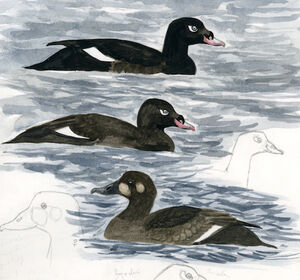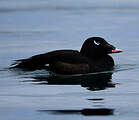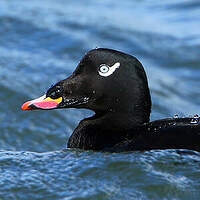White-winged Scoter
Melanitta deglandi - Macreuse à ailes blanches
Identification
The White-winged Scoter is a large American diving duck. The old taxon Brown Scoter has recently been split into 3 new species, the Eurasian Brown Scoter (or simply Brown Scoter), the Siberian Scoter that occurs in the east of the continent and the White-winged Scoter which nests in the north of the North American continent. The White-winged Scoter has thus become monotypic. This is what I'm going to treat here. The White-winged Scoter is very close in all respects to the Brown Scoter, to the point that the taxon is not yet recognized by all. It is recognized by the IOC*, which is why it is taken into account by oiseaux.net. I will only speak of what differentiates it from the brown.
It is the bill of the adult male that must be looked at properly. It is quadricolored, black, yellow, orange and pink. The black basal bulb already exists more developed than that of the male brown. The upper mandible, black at the base, is yellow in its upper part and pink on the sides, bordered by a black commissural line that widens forward. The nape is orange. The lower line of the bill, seen in profile, is straight while it is convex in the brown. Furthermore, the forehead is more rounded.
The adult female is dark brown, often with lighter spots more or less developed on the sides of the head as in the brown. Some have practically none. The bill is black to dark grey, without basal swelling, sometimes with reddish tones on the sides and towards the nape.
The juvenile is paler in plumage than the adult female, with more distinct pale spots on the sides of the head. Immature males in their 2nd year can be problematic and resemble females, but in principle, their plumage is darker.
Subspecific information monotypic species
Foreign names
- Macreuse à ailes blanches,
- Negrón aliblanco,
- negrola-ocidental,
- Höckersamtente,
- tükrös réce,
- Amerikaanse Grote Zee-eend,
- Orco marino del Pacifico,
- amerikansk knölsvärta,
- amerikasjøorre,
- turpan nosorohý,
- turpan kanadský,
- Amerikansk Fløjlsand,
- kyhmypilkkasiipi,
- ànec fosc americà,
- Kolönd,
- uhla garbonosa,
- Deglāna pīle,
- Горбоносый турпан,
- アメリカビロードキンクロ,
- 白翅黑海番鸭,
- 白翅海番鴨,
Voice song and call
Habitat
White-winged Scoters nest on freshwater and brackish lakes which provide them shelter and protection.
Dietfeeding habits
Like its counterparts, the White-winged Scoter mostly feeds on arthropods (crustaceans and insects) in its breeding grounds.
Among them, amphipods play an important role in its diet. Freshwater mollusks only come second. The dives are not deep, no more than 5 meters.In its wintering at sea, this is reversed. Mollusks play a primary role, bivalves and gastropods. Crabs and shrimps, starfish and polychaete worms come after. The dives are deeper, birds descending up to 20 meters below the surface with their webbed feet and wings functioning as fins.
Reproduction nesting
Nesting is very late, with laying usually occurring in June or even July. Under these conditions, it is likely that couples arrive on a nesting site together and already paired, and of course, only one brood would be the rule.
Nesting usually takes place a few tens of meters from the water and the ground nest is well hidden by dense, bushy vegetation. The female lays 8 to 10 pale beige eggs, spaced out at 36 hour intervals, in the nest lined with her own down. She incubates them until laying is complete, usually for around 27 days. The blackish-downy chicks, with pale cheeks and chin, remain in the nest for 12-24 hours, covered by the female. As soon as the down is dry after hatching, they can dive. In the days following they hunt actively for amphipod crustaceans, their main prey. Juveniles will only be able to fly at the age of 2 and a half months, as remiges grow slowly.Geographic range
The White-winged Scoter breeds in boreal and arctic areas of North America. Its range extends from James Bay to the Bering Strait and even a little beyond into Asia. All Canadian provinces are affected but with a distinctly western bias. In Quebec, it is only found around James Bay.
It winters along the Atlantic (from Newfoundland to the Gulf of Mexico) and Pacific coasts (from the Aleutian Islands to Lower California and north of the Gulf of California), and in the southern Great Lakes.
Threats - protection
Sources of information
- IOC World Bird List (v15.1), Gill, F and D Donsker (Eds). 2025-12-07.
- Wildfowl: An identification guide to the ducks geese and swans of the world, Madge, S and Burn, H
- Avibase, Lepage Denis
- Birds of the World, The Cornell Lab of Ornithology
- xeno-canto, Sharing bird sounds from around the world,
Other sources of interest
 Specification sheet created on
27/07/2023 by Jean François
Specification sheet created on
27/07/2023 by Jean FrançoisTranslation by AI Oiseaux.net
© 1996-2025 Oiseaux.net
- Accipitriformes
- Aegotheliformes
- Anseriformes
- Apodiformes
- Apterygiformes
- Bucerotiformes
- Caprimulgiformes
- Cariamiformes
- Casuariiformes
- Charadriiformes
- Ciconiiformes
- Coliiformes
- Columbiformes
- Coraciiformes
- Cuculiformes
- Eurypygiformes
- Falconiformes
- Galliformes
- Gaviiformes
- Gruiformes
- Leptosomiformes
- Mesitornithiformes
- Musophagiformes
- Nyctibiiformes
- Opisthocomiformes
- Otidiformes
- Passeriformes
- Pelecaniformes
- Phaethontiformes
- Phoenicopteriformes
- Piciformes
- Podargiformes
- Podicipediformes
- Procellariiformes
- Psittaciformes
- Pterocliformes
- Rheiformes
- Sphenisciformes
- Steatornithiformes
- Strigiformes
- Struthioniformes
- Suliformes
- Tinamiformes
- Trogoniformes



















